 NEWS
NEWS
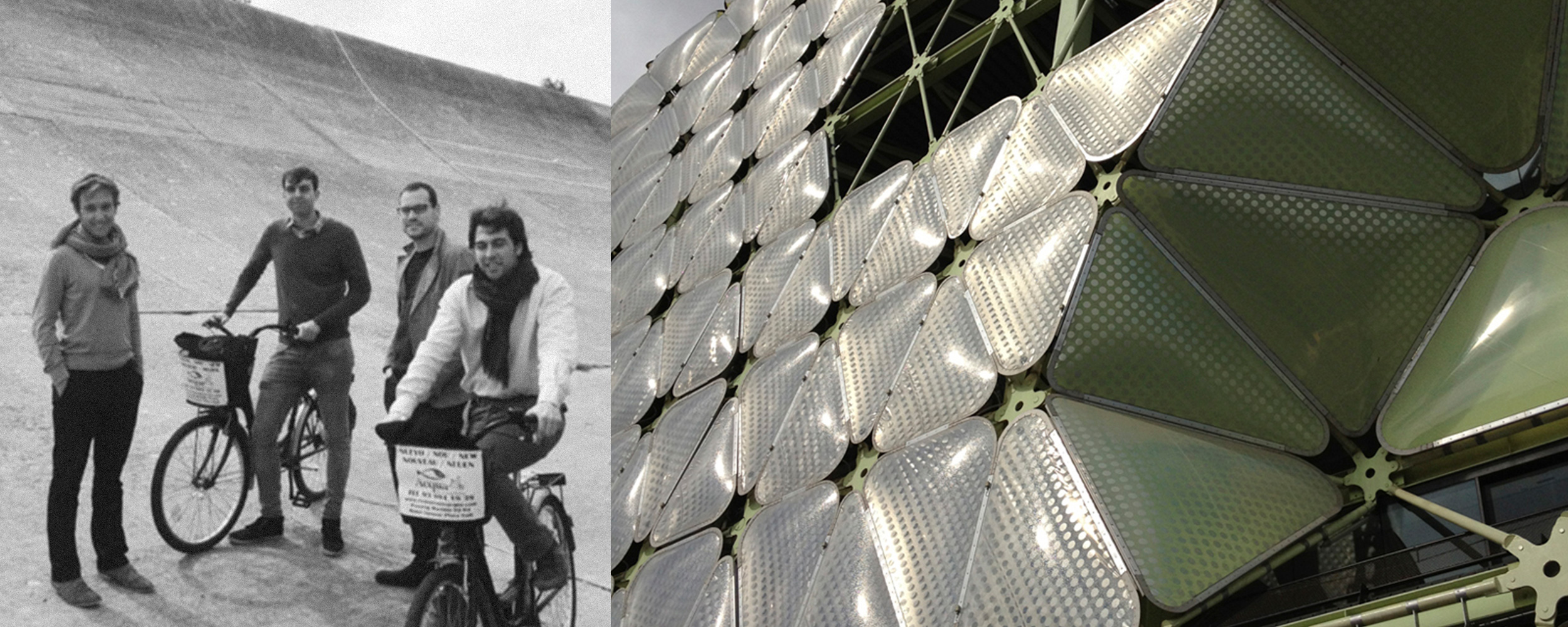
AA Visiting School Barcelona 2013, Faculty: Edouard Cabay, Carles Sala, Relja Ferusic and Pablo Ros.
Bodega, Enological Metabolism, AA Visiting School, Barcelona, 12-26 July 2013
In an endeavour inspired by the metabolic processes of wine production, Bodega, Enological Metabolism, one of the many Architectural Association Visiting Schools for architects and architectural students* to be staged this summer will be held in Barcelona from 12-26 July in collaboration with the ETSAB (Escola Tècnica Superior d’Arquitectura de Barcelona) and the Facultat d’Enologia de Tarragona/CEICS Enologia, URV Universitat Rovira i Virgili.
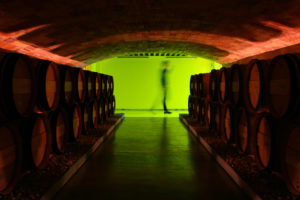
AA Visiting School Barcelona 2013, oak barrels, Menos da una piedra, Sala Ferusic Architects, Lagravera winery, Alfarràs, Lleida. Photo: Relja Ferusic.
The School will end with a Keynote lecture by Sir Peter Cook, CRAB Studio, London, and include open lectures by Jaime Coll, Coll Leclerc, Barcelona; Vicente Guallart, Chief Architect of the City of Barcelona; Enric Ruiz-Geli, Cloud9, Barcelona; Jordi Mansilla, Barcelona; Enric Batlle/Joan Roig, Batlle i Roig, Barcelona; Dr Fernando Zamora, Facultat Enologia Tarragona, URV; Dra. Montse Nadal and Dr. Joan Miquel Canals, Catedràtic Facultat Enologia Tarragona, URV.
The course will include some fieldwork – guided tours to the countryside to see some architectural examples of modern and contemporary wineries, for example, the Mas Rodó Vitinvinicola, Mediona, Barcelona, and Celler Lagravera, Alfarràs, Lleida, designed by Sala Ferusic, and in Barcelona, the Sagrada Família by Antoni Gaudí and the Media-TIC designed by Cloud9.
*The School is open to current architecture and design students, PhD candidates and young professionals. Software skills in Rhino and Grasshopper will be appreciated, but are not required.
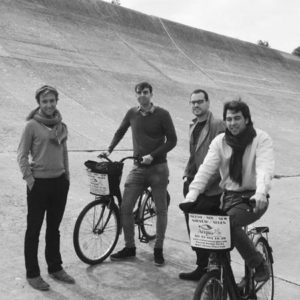
AA Visiting School Barcelona 2013, Faculty: Edouard Cabay, Carles Sala, Relja Ferusic and Pablo Ros.
Spain’s great heritage and tradition on wine production continues to be maintained as many wineries, in their pursuit of high quality to gain a foothold in the international market, today apply a highly accurate set of methods and techniques to ensure full control over the whole process of wine making as a means of optimization in enological design.
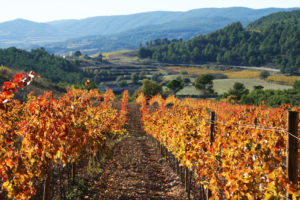
Mas Rodó Vitivinícola, Mediona, Barcelona, Sala Ferusic, Spring in Pantone 375c. Photo: Carles Sala.
The School will take its cue from this and use digital diagramming and mapping to ‘unfold the metabolism of wine production and dissect techniques and technologies involved in the processes.
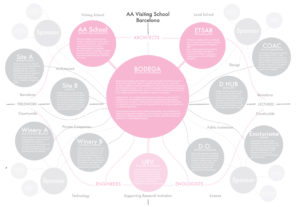
AA Visiting School Barcelona 2013, diagrammatic representation of all the bodies involved.
Underlining the characteristics of time information and feedback, we will recognize the potential of the use of control systems as an essential design tool’, explain the team members Edouard Cabay and Carles Sala, Director and Tutors of the School, Relja Ferusic and Pablo Ros, Coordinators and Tutors, and Anna Ramos and Mar Santamaria, Tutors. ‘Wine is the object of a field of science and technology: the characteristics that define it are the result of the combination of all the particularities of the process used in its making. These attributes will be the core object of our research, understanding them as the variables of a system, fed, as logics, into the definition of parametric models, which will become our design, both to analyse and to design.’
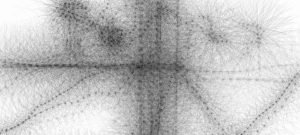
Atelier Cabay, Ecole Spéciale d’Architecture, student: Shujie Chen.
The students will be organised in groups and will focus on a different segment of the production. Equipped with analogic or digital tools, they will record quantitative information on site to understand the variable factors that can influence the quality of the wine. The object of this preliminary phase will be the creation of a series of drawings using digital tools to work on the cartographical representation of the mappings.
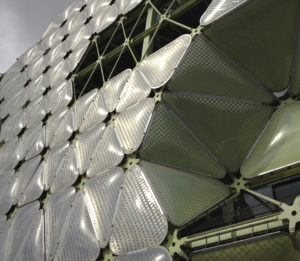
Media TIC, Barcelona, control systems. Photo: Rejla Ferusic.
Students will then be configured into new groups to tackle the design of a new winery based on the instrumentalisation of the relationship between the diagram of the production and potential architectural systems that can embed it. Enriched by the parametric maps produced in phase one, the groups will develop holistic design strategies in order to define the space, the construction technologies, the spatial organisations of the winery. The process of design will rely on the use of parametric tools and the potential of generative diagramming to embed the variables of the wine production. Students will invent possible schemes as systems that will emerge under the form of drawings, models, diagrams, and will be assisted in their design work by tutors and experts in parametric design tools. The early part of this phase will be a two day long design brainstorm, assisted by tutors, and then students will use the last few days to represent their scheme appropriately.
The results of will be presented on the last day of the workshop to a panel of experts from the architecture and enological world in a public presentation at the ETSAB. This will be the occasion for each group to explain their investigation and proposal, clearly highlighting the effects of their early mappings on the design and the use of parametric means and generative diagrams.The Faculty consists of Edouard Cabay and Carles Sala (Directors), Relja Ferusic and Pablo Ros (Coordinators) and the tutors will be Cabay, Sala, Ferusic, Ros, Anna Ramos and Mar Santamaria.
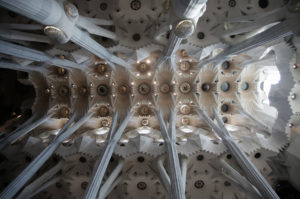
Sagrada Familia, Antoni Gaudi. Photo: Martin Abegglen.
Course schedule:
Day 1 – 12 July
General Introduction: day in school. Introductory words by the representative of the ETSAB and the course directors. Introduction of the brief frst mapping exercise by the course tutors, short presentation in parametric tools and methods of mapping. Formation of the groups of students who will work together in the frst phase of the workshop.
Day 2 – 13 July
Visit to a selected winery in the surroundings of Barcelona with tutors and neologists as an initial experience into the specificities of wine production and the space and infrastructure that it necessitates.
Day 3/4 –14/15 July
Two days on site at a selected winery to record information as mappings of the entire process of wine production. The collected information might be climatic, vegetal, territorial, technical, spatial, infrastructural, acoustic. The students will have to invent their own methodology of recording information, which could be a mere pencil and paper, laser meter, telephone app, for example. Tutors will be doing group tutorials.
Day 5/6 – 16/17 July
Two day work session in school during which the students will work on the graphic translation of the information collected on site in the previous visit of a winery. Between 10am and 12pm on both days, students will be given a class in parametric design. During the afternoon, they will be working in groups on the elaboration of their map. Tutors will be doing group tutorials.
Day 7 – 18 July, mid-July
Students will spend the morning in school completing their maps and preparing a short presentation. The presentation will occur in the afternoon and will be run by the course tutors as well as one or more external architects and oenologists. As a general discussion, the conclusions derived will form the core of the next exercise. Introduction to the second phase of the workshop. Formation of the groups of students who will work together in the second phase of the workshop.
Day 8 – 19 July
Work session in school. Between 10am and 12pm, students will be given a class in parametric design. During the afternoon, they will be working in groups developing their design proposal. Tutors will be doing group tutorials.
Day 9 – 20 July
Visit to a winery, the Sagrada Familia.
Day 10 – 21 July
Day off.
Days 11-14 – 22-25 July
Work sessions in school. Between 10am and 12pm on the 22 and 23 July students will be given a class in parametric design. The four days will be used by the students to develop and finalise their design proposal. Tutors will be doing group tutorials. Thursday afternoon and evening will be used to print and prepare models for the final jury.
Day 15 – 26 July
Final presentation and keynote lecture by Sir Peter Cook, CRAB Studio, London. Whole day presentation in the presence of to be defined and the tutors. This will be the occasion to reflect and engage in a critical discussion on the work produced during the two week workshop. Diploma ceremony. Following the keynote lecture, every participant receives an AA diploma, certifying their participation in the workshop. Final dinner for guest critics, students and tutors on the terrace of the ETSAB.